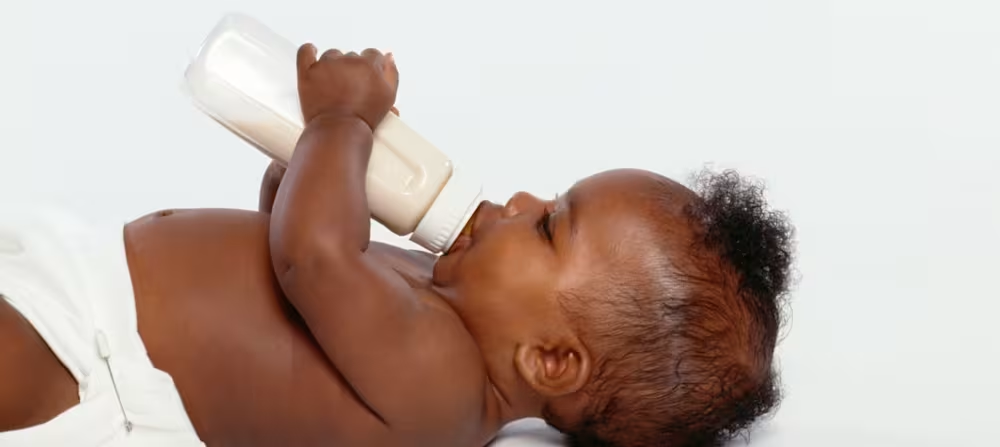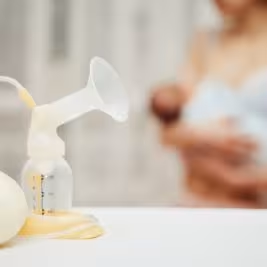How to wean off pumping: Expert strategies to stop pumping
Updated Jan 02, 2026

Every mom's breastfeeding journey is different. Some exclusively nurse, others solely pump, some do a combo of the two, and others mix in .
Although the American Academy of Pediatrics (AAP) [] recommends exclusively breastfeeding for at least the first six months, there is no wrong time to stop. But if a pump is part of your feeding plan, don't stop pumping cold turkey when you're ready to be done. Instead of abruptly ending, it's better to gradually stop pumping. Here’s how to wean off pumping for a smoother (and safer) transition for both you and your baby.
Table of Contents
How long does it take to wean off pumping?
Whether you’re eager to go pump-free as soon as possible or are just considering your pump exit strategy, note that it often takes time to safely transition away from pumping. Generally, the quickest someone with an established supply can wean off pumping is two weeks. But sometimes it can take a month or two. The exact amount of time it will take depends on individual circumstances including:
How long you’ve been breastfeeding: Moms who are in an earlier stage, like the first week postpartum, can typically wean faster than someone with an already . However, it will likely take a mom who is a few months in longer to completely suppress her milk supply than someone who’s 12 months postpartum. That’s because your milk supply may be higher before you introduce solids. As your baby starts eating more food, your milk supply can naturally dip.
Whether you’re exclusively pumping: If you’re already supplementing with breastfeeding or formula, you’ll have fewer pump sessions to wean away from.
How high your supply is: The more milk you’re producing, the longer it will likely take to transition away from the pump.
What your goals are: How quickly you want or need to be pump-free can impact how aggressive your plan should be to stop pumping.
Although the exact timing depends on the person, one thing that doesn’t change: you don’t want to go cold turkey. Doing so can lead to things like clogged ducts, mastitis, hormonal shifts, and overall discomfort.
Signs it may be time to wean from pumping
Sign #1 You have an oversupply
You may be an overproducer who has to pump often to manage your milk supply. Or, you’ve recently started feeling engorged with more milk than your baby needs as they start eating more solids. In either of these cases, you may want to start weaning to decrease your supply.
Sign #2 You’ve reached your goals
This is unique and personal to each pumping mom and her child. Some moms decide to wean off pumping after reaching their duration goals (whether it’s been two weeks or two years, it’s something to celebrate!). Other moms may want to stop once they’ve met their ounce goals and built up a freezer stash of stored breast milk. For example, if your goal is to provide breast milk for your child for their first year of life, you may be able to stop pumping earlier than expected if you’ve stored enough milk.
Sign #3 You’re physically uncomfortable
Pumping can be time-consuming, inconvenient, and, for some moms, painful. You might even be prone to unpleasant complications like bleeding from the nipple while pumping, clogged ducts, or mastitis. If you find each session physically uncomfortable, you might opt to pull back from pumping. (You may also want to speak with a lactation consultant to check your flange sizes and pump settings if you haven’t already).
Sign #4 You’re emotionally ready
Pumping can be empowering but also physically and emotionally difficult for some moms. It can impact your mental health, leaving some moms feeling anxious, depressed, or just overall not like themselves. You may also feel content with your journey and emotionally ready to transition to a pump-free lifestyle.
Sign #5 You’re exclusively breastfeeding instead
Some moms initially start pumping for a short-term reason, like their baby is in the or to help . But once they no longer need to pump, they may want to wean from pumping while continuing to breastfeed.
Sign #6 Your health
Some moms may need to wean for medical reasons [], like starting a medication that isn’t safe for breastfeeding.
Sign #7 You want to get pregnant
A common reason that moms want to stop pumping is to encourage their fertility. Although you can still get pregnant while breastfeeding [](even if you haven’t gotten your period back yet), nursing can suppress ovulation.
Sign #8 Your baby is eating more solids.
You may have a decreased need for breast milk due to your baby’s changing diet. Although breast milk (and/or formula) should be a baby’s primary source of nutrition [] for their first year, they may start drinking less [] as they begin . (Or be ready to drop a feed entirely on their own). So you may not need to continue pumping the same daily volume to satisfy your little one. This is normal!
Babies under 6 months old need an average of 30 ounces of breastmilk daily (though feeding needs vary). But after and as your little one approaches , the average goes down each month and ultimately ends up at about 16 ounces.
| Signs of readiness | Description |
|---|---|
| You have an oversupply | You’re naturally an overproducer, worked to increase your supply (a bit too much), or are pumping more milk than your baby needs now that they are eating solids |
| You’ve reached your goals | You pumped for as long as you set out to or have built up enough extra milk in a freezer stash |
| You’re physically uncomfortable | Pumping sessions hurt or you’re prone to painful complications like bleeding nipples, clogged ducts, or mastitis |
| You’re emotionally ready | You’re content with your journey and are ready to be done. Or, it’s impacting your mental health |
| You’re exclusively breastfeeding now | You no longer need pump sessions because you’re away from your baby or to help boost your supply |
| Your health | You need to start taking medicine that isn’t safe for breastfeeding |
| You want to get pregnant | You’re hoping to encourage ovulation |
| Your baby is eating more solids | Your baby is eating more — and drinking less |
Can you stop pumping cold turkey, or should you gradually reduce it?
If you’re pumping regularly, technically, you can just stop pumping. But should you? Almost never. If you abruptly stop pumping cold turkey, it can cause serious (and painful) problems, like clogged ducts and mastitis. This would very likely be the case for any lactating mom unless she is very new to breastfeeding (like within the first few days) or is 12+ months postpartum and already only producing very little milk.
Your body needs time to adjust, and the risks of stopping pumping cold turkey include:
You’ll likely become engorged
Can cause painful clogged ducts and milk blebs []
Increases your chances of getting a breast infection []
How can you avoid engorgement while weaning off pumping?
Don’t go cold turkey
Gradually space out pumping sessions
Slowly shorten the length of your pumping sessions
Don’t drop multiple pump sessions at once — aim to gradually reduce pumping frequency
Take sunflower lecithin [] to help reduce the stickiness of milk fat and allow the milk to stay in a liquid form longer. Always consult with a healthcare provider before starting supplements.
How do you handle clogged ducts while weaning off pumping?
When you wean from pumping too quickly instead of going for a gradual transition, you run the risk of becoming engorged. This happens when your breast doesn’t drain properly [] and swells with extra milk. You can become engorged if you suddenly go too long between pumping intervals or don’t empty your breast enough during sessions. Not only can engorgement be painful, but also it can lead to clogged milk ducts.
If you develop clogged or plugged ducts [], that means milk can’t properly flow. Instead, milk gets backed up and can lead to discomfort and possibly infection. If you develop clogged ducts while weaning off pumping, you may notice:
Breast pain
One or more hard, tender lumps in your breast
A milk bleb
Nipple bleeding while pumping
To unclog a blocked milk duct [], you want to avoid heat and instead:
Ice before and after pumping
Avoid vigorous massaging or trying to completely drain your breast (it can cause more swelling and encourage milk production)
Try lymphatic drainage []
Speak to your medical provider about taking sunflower lecithin []
Take ibuprofen and/or acetaminophen to help with swelling
Practice breast rest [] where you give that breast a break without over massaging it []. If possible, temporarily breastfeed directly instead of pumping. But if you exclusively pump, pump just what your baby needs instead of trying to completely empty your breast
Stay away from tight bras or clothing
If you start to feel sick or develop a fever, you may have mastitis. Consult your doctor or lactation consultant if this is the case to determine the best course of action.
Difference between weaning off pumping and weaning off breastfeeding
The main strategies for how to wean down pumping and weaning off breastfeeding are the same — like don’t go cold turkey! However, there are a few slight differences. This depends on whether you were exclusively pumping or breastfeeding and what the new feeding schedule you’re working towards looks like.
When you wean off pumping, you might continue breastfeeding (if you weren’t exclusively pumping). And while you may continue pumping even if you stop breastfeeding, your baby will move to bottle feeding — whether it’s formula, previously pumped and frozen breast milk, or freshly pumped milk until around their first birthday.
Weaning from pumping or breastfeeding can bring up a range of strong emotions, from sadness to relief to pride, as every journey is deeply personal. But when you wean off breastfeeding, the process can impact both mom and baby differently.
Weaning off breastfeeding
Baby might have big feelings when you stop breastfeeding. They’ll also be weaning away from mom’s breast as a source of food or comfort
Can take longer to complete as baby gets accustomed to exclusively taking a bottle
Can impact baby’s sleep if they rely on nursing to fall asleep or typically breastfeed right before naps
Baby can become impatient and fussier during feedings as your supply drops (and your letdown slows)
Might need to be more strategic about when you initially start (weaning could be harder if your baby is sick, teething, or already going through another developmental change)
Weaning off pumping
Can potentially take less time
Can create a strategic pump weaning schedule and stick to it
Doesn’t necessarily involve baby also learning how to drink from a bottle
Practical tips for smooth transition away from pumping
Tip | What to do | Why it helps |
|---|---|---|
Gradually drop sessions | Eliminate one pumping session at a time, starting with late-night or low-supply sessions | Prevents sudden engorgement and protects against clogged ducts |
Shorten sessions slowly | Reduce pumping time by a few minutes and gradually extend the time between sessions | Signals your body to decrease milk production gently |
Space out changes | Wait about 3 days between reductions in time or frequency | Gives your body time to adjust and lowers mastitis risk |
Listen to your body | Pause or slow down if you notice pain, redness, or clogged ducts | Prevents complications and supports a safer weaning process |
Use comfort supports | Wear supportive bras, use breast pads, and avoid tight or binding bras | Reduces discomfort without increasing inflammation |
Use ice, not heat | Apply cold packs as needed and avoid heat | Helps suppress milk production and calm inflammation |
Try cold cabbage leaves | Apply chilled cabbage leaves every 2 - 3 hours if aiming to wean faster | May help reduce milk supply and relieve engorgement |
Review supplements | Stop milk-boosting supplements and consider sunflower lecithin if prone to clogs | Supports smoother weaning and duct health |
Find more information below:
Tip #1 Gradually reduce the number of times you pump
As you consider how to stop pumping milk, avoid cutting down more than one session at a time. Instead, strategically pick a session to drop first. The first one to go will depend on when and how many times a day you’re pumping. You’ll likely want to start with a late-night feed if you’re pumping in the middle of the night or a late-afternoon session because your supply is naturally lower during those times.
Tip #2 Slowly decrease how long you pump (and increase time between sessions)
Instead of drastically cutting how long you pump during each session, reduce the time gradually. For example, if you usually pump eight times a day for 20 minutes, start by dropping down to seven sessions and reduce the time to 18 or 15 minutes each.
When you shorten the duration of your feeding sessions, you’re subtly extending how long you go between pumping. For example, if you’re a mom who only pumps while at work, try to shorten your sessions while also going longer between the two. So instead of pumping for 20 minutes every 3 hours, try going 3.25 hours between sessions and then eventually 3.5 hours as you also reduce the time to 18, 15, 10 minutes, etc.
Tip #3 Space out changes
As you reduce the number of pumping sessions and duration, give your body a chance to adjust. It’s often best to wait around three days between changes. For instance, if you cut sessions from 18 to 15 minutes on day 1, we recommend waiting until day 4 to cut them down again to12 minutes.
Tip #4 Listen to your body
Start by figuring out your ideal timeline. Someone who wants or needs to wean as quickly as possible may try a more aggressive weaning plan than someone who’s able to be more flexible. Even if you mapped out a strategic weaning plan and are eager to stick to it, it’s best to listen to your body and evaluate how you’re doing at each stage. Check in with yourself to see if you’re comfortable, and don’t just jump to the next step because it’s been three days. If you notice clogged ducts, irritation, or redness, it’s best to pause the plan. You may need to temporarily increase pumping for comfort and to avoid getting mastitis. Or, you could try some hand expression to relieve some of the pressure (without completely draining your breast). After you take some time and feel better, resume the weaning plan.
Tip #5 Use comfort measures
Weaning isn’t always pleasant, but there are some things that may help. Have breast pads on hand in case you leak while extending your sessions. And make sure you’re wearing comfortable yet supportive bras. Avoid any that are tight or compress your breasts. And never bind your breast []. This doesn’t suppress lactation [] — it increases your chances of having pain, a clogged duct, or developing mastitis.
Tip #6 Use ice (and skip heat)
Weaning moms can benefit from using ice packs [] on their breasts as they’re able to throughout the day. But if you don’t have time for ice during the day or while working, icing even just first thing in the morning and before you go to bed can help. Using cold compresses helps suppress your milk production and reduce inflammation — so you won’t feel as full, firm, and uncomfortable.
In the past, heat was a common recommendation to help with engorgement, clogged ducts, and mastitis. But it can actually make things worse by increasing blood flow and inflammation [], which puts more pressure on the blocked ducts that you’re trying to drain.
Tip #7 Try cold cabbage leaves
To help reduce your milk supply as you wean from pumping, you can put cold cabbage leaves on your breasts []. How often you do so depends on your goals. If you have a faster weaning schedule and are trying to be done with pumping as soon as possible, you can put fresh cold cabbage leaves on every 2 to 3 hours and keep them on for as long as you like.
Tip #8 Consider the supplements you’re taking
If you’ve been taking any supplements to help encourage or maintain your milk supply and want to wean from pumping, now is the time to stop. You may also want to speak to your healthcare about taking sunflower lecithin [] to help prevent clogged ducts.
Tip #9 Try lymphatic drainage
Instead of trying to move milk down and out towards the nipple with a vigorous massage, try a lymphatic drainage massage []. With this practice, you lift milk up and encourage it to leave your body with gentle, sweeping strokes [] toward your armpits and upper chest. This helps your body to absorb the milk instead of you trying to push it through the clogged duct and squeeze it out.
If you massage too vigorously (with your hands or a massager), you can actually increase inflammation and milk production. Think of it like trying to get through traffic: If there’s an accident, narrowing the road or adding even more cars to the pileup isn’t going to help you get through any faster. It’s just going to cause an even bigger traffic jam.
When to seek professional advice
If you experience symptoms of a persistent clogged duct or mastitis, it’s important to contact your lactation consultant or doctor as soon as possible. These include:
Breast redness, irritation, or red streaking pattern
Body aches
Feeling sick or like you have the flu
Fever
Hot flashes
Breast that is hot to the touch
Dense breast lumps (or clogged milk ducts)
A milk bleb
Takeaway
The decision of when to stop pumping is personal, and there is no right or wrong answer.
Weaning from pumping is a gradual process that takes time for your body to adjust.
Avoid going cold turkey, making abrupt changes, or rushing the process.
Listen to your body and be flexible with your weaning schedule.
Check in with your doctor or lactation consult if you get a persistent clogged duct or develop signs of mastitis.
How to wean off pumping FAQs
- Painful, swollen breasts
- Blocked or plugged milk ducts
- A milk bleb
- Redness or streaks on your breast
- A warm breast
- Body aches or feeling like you have the flu
- A fever
Share article:
Note: The content on this site is for informational purposes only and should not replace medical advice from your doctor, pediatrician, or medical professional. If you have questions or concerns, you should contact a medical professional.
19 Sources
Table of Contents
Share article:





